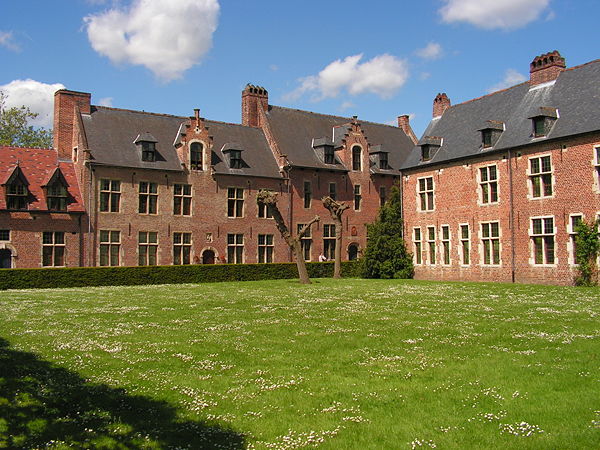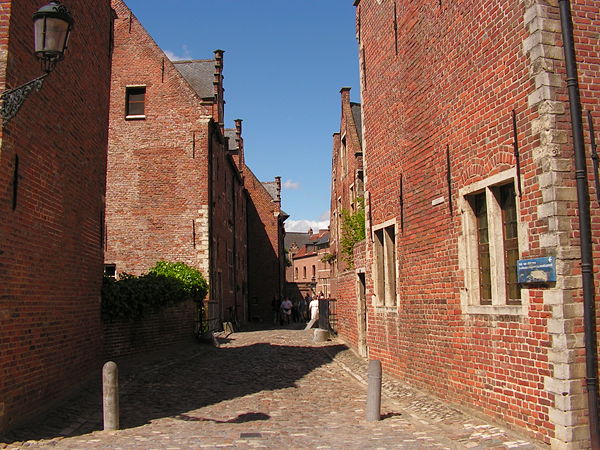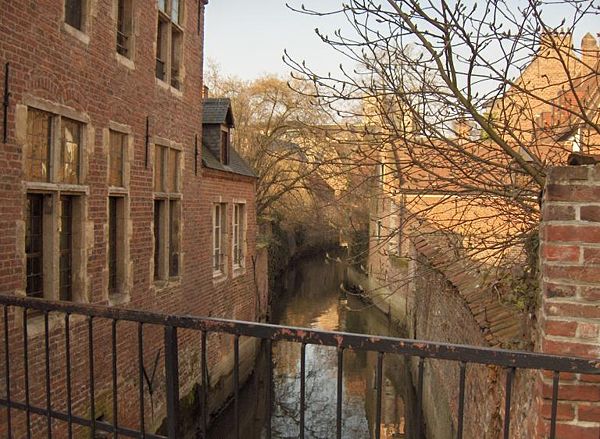Het Groot Begijnhof
Schapenstraat, B-3000 Leuven

[NEDERLANDS]
Een begijnhof is een verzameling van individuele en/of gemeenschappelijke woningen, huizen en conventen genoemd, van begijnen meestal in de nabijheid van een kapel of kerk en al dan niet omgeven door een muur met een of meerdere toegangspoorten. Begijnen waren vrouwen die hun leven aan God wijdden, zonder zich uit het wereldse leven terug te trekken. In de 13de eeuw stichtten zij daartoe eigen woongebieden, genoemd begijnhoven. Deze vormden ommmuurde gemeenschappen die aan hun spirituele en materiële behoeften tegemoet kwamen.
Het Groot Begijnhof van Leuven, ook bekend als Begijnhof Ten Hove, werd begin 13de eeuw gesticht, buiten de toenmalige stadsmuren. Vandaag is het een gaaf bewaarde, en volledig gerestaureerde historische wijk van een tiental straten in het zuiden van de binnenstad en een van de grootste nog bestaande begijnhoven in Vlaanderen, met een bebouwde oppervlakte van ongeveer 3 ha. De Dijle stroomt dwars door het hof en splitst er in twee armen (plus een verbindingsslootje), waarover in totaal drie bruggen liggen. De oudste huizen dateren uit de 16de eeuw, toen de oorspronkelijke lemen woningen in steen herbouwd werden. Sommige van de 72 huizen werden genoemd naar een heilige of naar een gebeurtenis uit het testament.
De Sint-Jan-de-Doperkerk is vroeggotisch: een gedenksteen in de rechtersteunbeer vermeldt 1305 als bouwjaar.
Bij de afschaffing van het begijnhof in 1795 leefden er 198 begijnen. De welgesteldenonder hen beschikten over een particuliere woning. Armere begijnen leefden samen in 'conventen', gemeenschapshuizen. Voor de zieke en arme oude begijnen was er een infirmerie.
Het Groot Begijnhof lijkt wel een stadje in de stad. Het is een aaneenschakeling van straatjes, pleintjes, tuinen en parkjes, met tientallen huizen en conventen in traditionele bak- en zandsteenstijl. dit stadje werd tussen 1964 en 1989 gerestaureerd door de KULeuven, die sde site in 1962 had gekocht van de toenmalige Commissie van Openbare Onderstand. Vandaag wonen er studenten en universiteitsmedewerkers. In De kerk werd in erfpacht gegeven aan de K.U.Leuven. De oude infirmerie wordt ingenomen door de Faculty Club, een ontmoetingscentrum voor het personeel van de K.U.Leuven. Het Convent van Chièvres (huis nr. 39) is ingericht als centrum voor congressen.
Op 31 maart 2000 het erkend als werelderfgoed van de UNESCO.
Open: permanent vrij toegankelijk
Kerk: 1 april - 30 september: van dinsdag tot en met zondag: van 13.30 uur tot 16.30 uur

[ENGLISH]
A Béguinage is a collection of small buildings used by Beguines, which were several lay sisterhoods of the Roman Catholic Church, founded in the 13th century in the Low Countries, of religious women who sought to serve God without retiring from the world. A "Begijnhof" (as the Dutch name is) or Béguinage comprises a courtyard surrounded by small dwellings. It is often encircled by a wall and secluded from the town proper by one or two gates. Poor and elderly beguines were housed here by benefactors. Béguinages are to be found in an area roughly corresponding with present-day Northern and North-Eastern France, Belgium, the Netherlands, Western and North-Western Germany.
The Grand Béguinage of Leuven (Dutch: Groot Begijnhof van Leuven), which was founded in the 13th century outside the town wall of the time, is today a well preserved and completely restored historical quarter containing a dozen of streets in the south of downtown Leuven. About 3 hectares (7.5 acres) in size, with some 300 apartments in almost 100 houses (the oldest houses date from the 16th century), it is one of the largest still existing beguinages in the Low Countries. The béguinage stretches on both sides of the river Dijle, which splits into two canals inside the béguinage, thus forming an island. Three bridges connect the parts of the beguinage. The complete béguinage is owned by the University of Leuven and used as a campus, especially for housing students and academic guests.
The church, dedicated to St. John the Baptist, is early Gothic. The date of construction, 1305, is carved into the right buttress of the north portal.
Approximately 300 'Begijns' lived in the 'Begijnhof' in the 17th century. The 'Begijns' or 'Beguines' were women who lived a religious life but kept their own property and supported themselves. They did not make perpetual vows. The movement was very strong throughout the Low Countries.
The 'Begijnhof' was taken over by the Welfare Commission in 1925. Except for the church, it was sold to the University in 1962 under the condition that the entire complex was to be restored. A year later the Restoration began under the direction of Professor R. Lemaire. Nowadays, it is a University residential quarter for students, professors, and employees of the University. Foreign guests are also housed here. There is room for 500 people. The Infirmary of the 'Begijnhof' has been converted into the Faculty Club, a place for the academic, scientific, administrative, and technical staff of the University to meet. The Chièvres Convent (Nr. 39) has been converted into a congress center.
On 31th March 2000, it was officially recognised as an UNESCO World Heritage site.
Open: every day
Church: 1st April - 30th September: from Tuesday to Sunday from 1.30 p.m. - 4.30 p.m.

Foto CC-BY-2.0-BE Maarten Jansen
[CESKY]
Ceský preklad zde není, nicméne pokud se plánujete nacházet v blízkosti cache, urcite mne predem kontaktujte - velmi rád se setkám a mohu poskytnout komentár osobne :-) V Belgii zustávám do února 2009.
INTERNET
